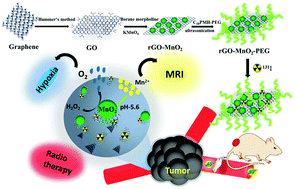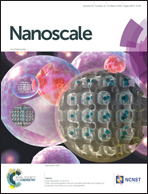Nano-graphene oxide-manganese dioxide nanocomposites for overcoming tumor hypoxia and enhancing cancer radioisotope therapy†
Abstract
While radiotherapy (RT) is commonly used in clinics for cancer treatment, the therapeutic efficiency is not satisfactory owing to the existence of the hypoxic tumor microenvironment which seriously affects the efficiency of RT. Herein, we design polyethylene glycol (PEG)-modified reduced nano-graphene oxide-manganese dioxide (rGO-MnO2-PEG) nanocomposites to trigger oxygen generation from H2O2 to reduce the tumor hypoxic microenvironments. We use the radioisotope, 131I labeled rGO-MnO2-PEG nanocomposites as therapeutic agents for in vivo tumor radioisotope therapy (RIT), achieving excellent tumor killing and further enhancing the therapeutic efficiency of RIT. More importantly, the dissolution of MnO2 under acidic conditions and the redox process during the catalytic pathway of H2O2 decomposition in the cellular microenvironment direct to the production of an enormous amount of Mn2+ which has been used as a contrast agent for magnetic resonance imaging (MRI). Our proposed work provides a strategy to trigger oxygen formation via an internal stimulus to enhance imaging-guided RIT efficiency.



 Please wait while we load your content...
Please wait while we load your content...